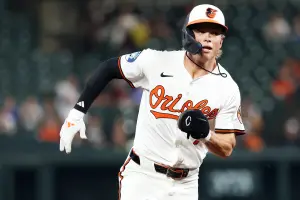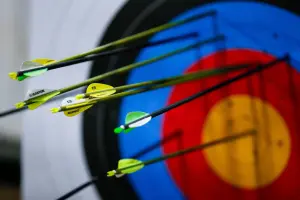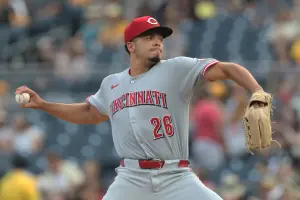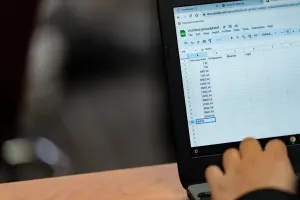
(*) ROTISSERIE: LABR: What is value?
How do you define “value?” In 1828, Noah Webster said “the value of a thing is what it will bring to market.” Unfortunately, extensive historical research has shown that Mr. Webster never played fantasy baseball, so we’ll have to look elsewhere to define the context for our wonderful game.
The question of value comes about because in “Winning Fantasy Baseball,” Larry Schecter espoused the need to define dollar values for statistical projections—to the penny—and not to top those values in bidding. With numerous victories in Tout Wars, LABR, and various high-stakes games, you ignore Larry’s advice at your own peril. Ron Shandler discussed this in January, when he described the “terror of Larry Schecter’s book.”
LABR and offense
As I approached my recent involvement in AL-only LABR, I again asked myself—how does one define value?
Seven years of experience in LABR tells me that if you simply walked into the room with a list of unadjusted BaseballHQ.com dollar values from the website, you’d be in for a world of hurt. The offensive studs in this league always go over their expected value; with a general decline in offense in MLB, all owners now put a premium on power. What that means is that if you wait for profits based on your dollar values, you’ll find yourself purchasing lower-priced players. In other words, for every $30 stud who goes for $32, there’s an $8 player later in the draft who goes for $6. But if you don’t get some of the higher-priced studs, you won’t get enough stats to compete for the title.
Since I knew I’d have to partake in the spending on the power studs to be competitive, I came in with a plan to adjust the BHQ dollar values for the tendencies of the league, and look for "value" later in the auction, when the bargains did start to appear.
Strategy—hitting
In a recent online mock draft, Ron Shandler was willing to overspend on…wait for it…Mike Trout, and was content to look for value elsewhere. While Ron was successful in getting a bunch of value players, it was after setting up the Custom Draft Guide (CDG) to be offense-heavy.
I use Rotolab so that I can track the auction in real time. I set it up for a valuation similar to Ron's, changing from the default 66/34 hitting/pitching split used by the CDG to a hitting-heavy 70/30 split. Also, while the CDG takes a balanced approach to Stars and Scrubs vs Spread the Risk, I changed Rotolab to stress Stars and Scrubs on offense and Spread the Risk on pitching.
Rather than concentrate on Trout, though, I decided to overspend on more traditional power hitters (Mayberry scores of 4-5 in the power category). Since speed is not as scarce as it once was, I would look for my speed sources later in the draft, hopefully at good prices in my adjusted valuation system.
Strategy—Pitching
My starting pitching staff is what did in my 2013 AL-LABR team. Rather than buying a stud starter, I bought several $5-10 starters. I then proceeded to “exercise excruciating patience” when they got off to a slow start. Mistake. As detailed in the 2014 Baseball Forecaster, starting pitchers who get off to a slow start have a very hard time earning their value over the rest of the year.
Still, I have an aversion to spending big on starting pitchers, By spreading the risk, I would again concentrate on starters in the $10-15 range; but this time I would be more selective on whom I chose in that price range.
After discussing things with NL-LABR participant and LABR/XFL winner Doug Dennis, who has had extensive success in building winning teams with low-priced pitching staffs, I created a list of starters with projected Dom > 6.8, Cmd > 2.4, hr/9 < 1.0, and xERA < 3.80. My goal was to spend $60 or less on pitching, but I wasn’t going to hold hard to that if good pitching was available late at reasonable cost.
The key for me in 2014 is to adjust my in-season strategy—I hearby vow not to exercise much patience with low-cost starters. If one starts poorly, I will cut him and pick up a middle reliever with exemplary skills, and keep him until there is a starter with good skills on the waiver wire.
Also, since LABR has a DL list separate from the rest of the reserve list, if I could get an injured starter for a buck or two at the draft, I would do that and stash him.
How to anticipate value players
Even with my adjusted value system for LABR, I still wanted to be able to identify in advance players who could provide some profit.
One way is to look at the 2014 Forecaster’s RandVar calculations. RandVar measures the impact of random variance on a player’s 2013 stats (things like h%, hr/f, and xBA-BA for hitters; H%, S%, and XERA-ERA for pitchers). RandVar varies between -5 and 5; players with high positive scores are those to target; the negative end has players to avoid.
Another way to judge the value of players against the perception of others is through Matt Cederholm’s excellent Market Pulse columns. While Matt deals with drafts and ADP rankings rather than auctions, it’s a good way to get a sense of what players are undervalued, and which are overvalued.
And while some experts don’t publish their projections, others do. By comparing the BHQ values to the published values of a few of my competitors, I was able to get a sense of where I could expect to find some players going under my adjusted BHQ values.
The team
The AL experts gathered last Saturday night; it was much like the rumble between the Sharks and the Jets on West Side Story. Here’s the BaseballHQ.com team:
Pos Name Team Sal $R Mayberry === =============== ==== === == ============ C Avila, Alex DET 8 9 4215 60 BCD C Suzuki, Kurt OAK 1 4 1223 24 ACB 1B Encarnacion, Edw TOR 34 28 4255 80 BAC 3B Middlebrooks, Will BOS 16 17 4225 65 CCF CO Morales, Kendry FA 7 17 3025 50 FCA 2B Altuve, Jose HOU 23 22 1435 65 ABB SS Aybar, Erick LAA 14 17 1445 70 BAA MI Forsythe, Logan TAM 2 4 3423 60 DDC OF Gordon, Alex KC 22 24 3325 65 AAB OF Jones, Adam BAL 33 33 4345 80 AAA OF DeAza, Alejandro CHW 15 21 2425 65 AAA OF Hoes, L.J. SEA 3 7 1323 45 ACB OF Shuck, J.B. LAA 1 3 0323 40 ACC UT Sizemore, Scott NYY 1 5 3313 30 FFF SP Kluber, Cory CLE 13 11 4305 80 CCC SP Archer, Chris TAM 14 12 3303 48 ADC SP Smyly, Drew DET 12 12 4403 60 BDD SP Porcello, Rick DET 11 11 4203 52 AAA SP Richards, Garrett LAA 7 7 3203 33 ACB SP Milone, Tom OAK 1 3 3301 30 ABA RP Bell, Heath TAM 2 0 4510 14 ABB RP Cook, Ryan OAK 1 2 4500 0 ACB RP Uehara, Koji BOS 19 20 5531 76 FCA RES Capuano, Chris BOS 0 4201 15 DAA RES Cecil, Brett TOR 0 4510 14 ACB RES Schoop, Johnathan BAL 0 RES Wallace, Brett HOU 0 4103 36 ACB RES Lavarnway, Ryan BOS 0 2001 5 ADB RES Gibson, Kyle MIN 0 2103 24 DDC
Mayberry score breakdown:
Batting PX RSpd xBA PA MM ======= == ==== === == === Actual 34 39 34 60 799 Target 37 23 32 54 600 Pitching xERA K Sv IP MM ======== ==== == == == === Actual 34 32 4 19 393 Target 17 27 5 25 320
How it went
On offense, it went as planned—Stars and Scrubs garnered me plenty of offense, along with some low-priced question marks and place holders. While I overpaid for Encarnacion, he was on both my Mayberry power and +5 RandVar lists. Jones, another name from my Mayberry power list, was purchased at value. Middlebrooks also came from the positive RandVar list. Aybar was on the list of players undervalued by other participants. Other than Altuve, the rest of the offense was value players compared to my juiced-up valuation system.
With pitching, I spread the risk, eschewing stud starters and keying on guys in the $11-15 range. Six of my starters met my filter requirements; three (Richards with slightly lower Dom/Cmd; Milone with sightly elevated xERA and hr/9; Bell with slightly higher hr/9) just missed. Porcello is on the +5 RandVar list; Archer and Smyly were included on my list of players that may be undervalued by my competitors. I was surprised to end up with Uehara; I thought he would go for more than $19. But the lack of bargains meant that I spent more on pitching ($80) than I expected.
Mayberry Score—Did I meet the standard goals?
On offense, I'm a little short on power, but have a surplus of speed to address any needs via trade. Most importantly, I topped the playing time target. With pitching, I’m in excellent shape with ERA, have adequate Ks, but my starters aren't projected to put up a lot of innings.
Summary
My goals going into the auction were met; this team is in good position to compete. It’s going to be a dogfight in AL-LABR this year, and my goal is to take down the lead dog and defending champ Larry Schechter, who put together a fine team as usual.









